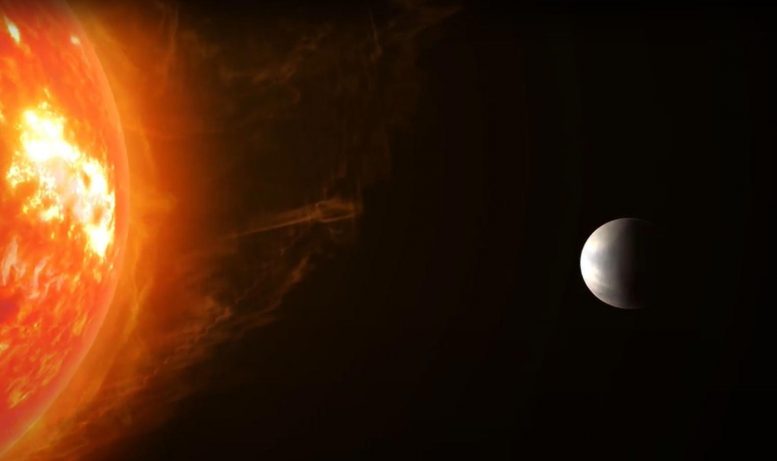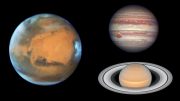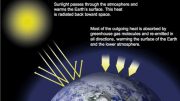Using both transit and radial velocity data, researchers discovered Gliese 486 b — a super-Earth exoplanet orbiting the nearby red dwarf star Gliese 486.
At only 8.1 parsecs from Earth, Gliese 486 b is the third-closest transiting exoplanet known — and the closest that transits a red dwarf star with measured mass. This makes it an ideal candidate to search for an atmosphere and study its habitability, according to the study’s authors.
“Gliese 486 b is not hot enough to be a lava world,” Trifon Trifonov and colleagues write, “but its temperature of ~700 Kelvin (430 Celsius) makes it suitable for emission spectroscopy and phase curve studies in search of an atmosphere.”
Most exoplanets are discovered using one of two indirect methods; transit photometry, which searches for slight variations in a star’s brightness as a planet passes in front of it, or Doppler radial velocity (RV), which measures the “wobbling” of stars due to the gravitational pull of orbiting planets. While each method has been used to discover numerous extra-solar worlds, alone, they only provide limited information about a planet’s physical properties.
However, in the rare cases where an exoplanet can be detected using both techniques, a great deal can be learned, including its mass, radius and density. By applying both, Trifonov and colleagues present the detection of planet Gliese 486 b. Gliese 486 b is a terrestrial planet with an orbital period of 1.467 days around the star Gliese 486 — a nearby red dwarf roughly 26 light-years away.
This virtual journey to Gliese 486b begins with its position in the night sky. After focusing on the parent star Gliese 486b, the film depicts the measurements. Finally, we fly to the exoplanet Gliese 486b and explore its possible surface, which probably resembles Venus, with a hot and dry landscape interspersed with glowing lava flows. Credit: RenderArea
According to the authors, the hot rocky planet is slightly larger than Earth (~1.3 times Earth’s radius) yet is more than twice as massive (~2.81 Earth masses). Gliese 486 b also has a similar density to Earth, suggesting it has an iron-sillicate composition like that of our home planet. What’s more, the planet has an equilibrium temperature of about 700 Kelvin, which is only slightly cooler than Venus and is suitable for transmission and emission spectroscopy.
Combined with its proximity and the fact that it is bright and highly visible using telescopes anywhere on Earth, future studies could provide valuable insights into the atmospheric properties and habitability of the distant planet.
For more on this discovery:
- Alien Super-Earth Planet Discovered Just 26 Light Years Away – Probably Has an Atmosphere
- Earth Has a Hot New Neighbor – And It Could Change How We Look for Life in the Universe
Reference: “A nearby transiting rocky exoplanet that is suitable for atmospheric investigation” by T. Trifonov, J. A. Caballero, J. C. Morales, A. Seifahrt, I. Ribas, A. Reiners, J. L. Bean, R. Luque, H. Parviainen, E. Pallé, S. Stock, M. Zechmeister, P. J. Amado, G. Anglada-Escudé, M. Azzaro, T. Barclay, V. J. S. Béjar, P. Bluhm, N. Casasayas-Barris, C. Cifuentes, K. A. Collins, K. I. Collins, M. Cortés-Contreras, J. de Leon, S. Dreizler, C. D. Dressing, E. Esparza-Borges, N. Espinoza, M. Fausnaugh, A. Fukui, A. P. Hatzes, C. Hellier, Th. Henning, C. E. Henze, E. Herrero, S. V. Jeffers, J. M. Jenkins, E. L. N. Jensen, A. Kaminski, D. Kasper, D. Kossakowski, M. Kürster, M. Lafarga, D. W. Latham, A. W. Mann, K. Molaverdikhani, D. Montes, B. T. Montet, F. Murgas, N. Narita, M. Oshagh, V. M. Passegger, D. Pollacco, S. N. Quinn, A. Quirrenbach, G. R. Ricker, C. Rodríguez López, J. Sanz-Forcada, R. P. Schwarz, A. Schweitzer, S. Seager, A. Shporer, M. Stangret, J. Stürmer, T. G. Tan, P. Tenenbaum, J. D. Twicken, R. Vanderspek and J. N. Winn, 5 March 2021, Science.
DOI: 10.1126/science.abd7645











Be the first to comment on "Earth Has a Hot New Neighbor: Discovery of a Nearby Exoplanet Suitable for Atmospheric Investigation"